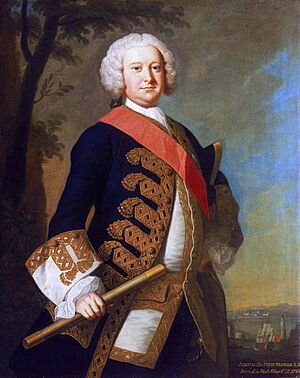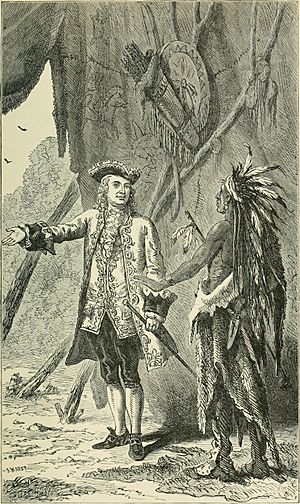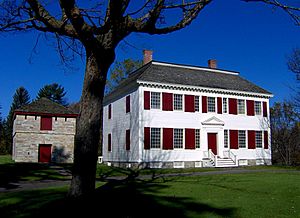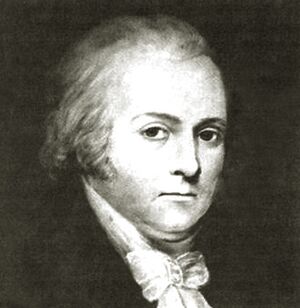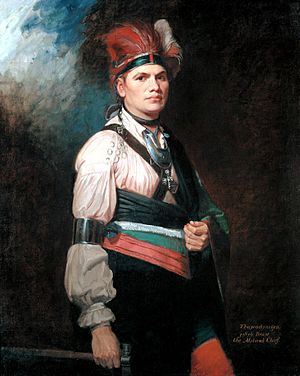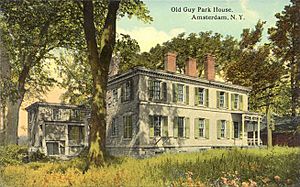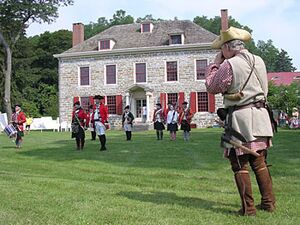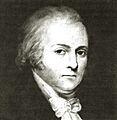Sir William Johnson, 1st Baronet facts for kids
Quick facts for kids
Sir William Johnson
|
|
|---|---|
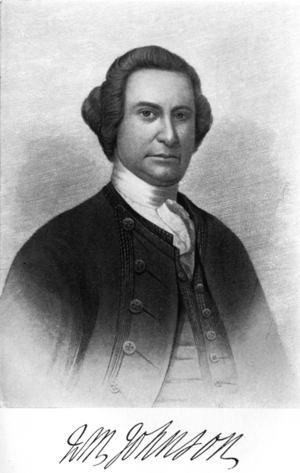
Sir William Johnson in 1763, based on a lost portrait by Thomas McIlworth
|
|
| Personal details | |
| Born | c. 1715 County Meath, Ireland |
| Died | 11 July 1774 (aged 58–59) Johnstown, New York |
| Military service | |
| Allegiance | |
| Branch/service | |
| Years of service | 1744–1774 |
| Rank | Major-General Superintendent of Indian Affairs |
| Commands | Expedition to Crown Point Expedition to Fort Niagara |
| Battles/wars | |
Sir William Johnson (born around 1715, died 1774) was an important British official and army officer from Ireland. When he was young, Johnson moved to New York to manage land his uncle, Peter Warren, had bought. This land was in the area of the Mohawk, who were part of the Iroquois League.
Johnson learned the Mohawk language and their customs. Because of this, he became the main British contact for the Iroquois. In 1756, he was made the British Superintendent of Indian Affairs for all the northern colonies. He became very wealthy, partly by buying large amounts of land.
Johnson led Iroquois and colonial soldiers against the French and their allies during the French and Indian War (1754–1763). His role in the British victory at the Battle of Lake George in 1755 earned him a special title, a baronetcy. His capture of Fort Niagara from the French in 1759 made him even more famous. He worked to keep Native Americans allied with the British until his death in 1774.
Contents
Early Life and Career in Ireland
William Johnson was born around 1715 in County Meath, Ireland. His parents were Christopher Johnson and Anne Warren. His mother's family had lost much of their land and status over time.
William's paternal grandfather had changed his last name to "Johnson," which was an English version of an Irish name. Some stories say William grew up poor, but he actually had a comfortable life.
As a Catholic, William Johnson had few chances to get ahead in the British Empire. He wasn't very religious, so he became a Protestant when his uncle, Peter Warren, offered him a job in British America. Peter Warren was a successful officer in the British Navy who became very rich.
Moving to the Colonies
Peter Warren bought a large area of undeveloped land along the Mohawk River in New York. Warren convinced Johnson to start a settlement there, which would be called Warrensburgh. Johnson arrived around 1738 with twelve Irish Protestant families. They began to clear the land. He used enslaved people to help clear the land.
Warren wanted Johnson to trade with American Indians, especially the Mohawk and other Iroquois nations. Johnson soon found that the best trade routes were on the other side of the river. In 1739, he bought a house and a small farm there. He built a store and a sawmill at this new location, which he called "Mount Johnson."
From Mount Johnson, he could trade directly with New York City merchants, avoiding the middlemen in Albany. This made the Albany merchants angry.
Johnson became very close with the Mohawk. By the time Johnson arrived, their population had shrunk due to diseases brought by Europeans and wars over the fur trade. The Mohawk believed that an alliance with Johnson could help them with the British. Around 1742, they made him an honorary sachem, or civil chief. They gave him the name Warraghiyagey, which he said meant "A Man who undertakes great Things."
King George's War
In 1744, a war in Europe called the War of the Austrian Succession spread to colonial America. Here, it was known as King George's War. Because of his strong connection with the Mohawk, Johnson was made New York's agent to the Iroquois in 1746. He was also named "Colonel of the Warriors of the Six Nations." His job was to recruit colonists and Indians to fight against the French.
It was hard to get Iroquois warriors to join. Since 1701, the Iroquois nations had tried to stay neutral in wars between France and Great Britain. But Johnson, working with the Mohawk chief Hendrick Theyanoguin, convinced Mohawk warriors to fight for the British.
Johnson organized small groups of raiders to attack French settlements. In July 1748, news arrived that the war had ended. The Mohawk had lost many warriors, which made Johnson less popular with them for a while.
In 1748, Johnson built a new stone house upriver from Mount Johnson. This house became known as Fort Johnson. It was heavily fortified when the next war started. In 1755, Johnson moved the main meeting place for British and Iroquois leaders from Albany to Fort Johnson.
After King George's War, Johnson had problems with rival politicians in New York. He resigned as New York's Indian commissioner in 1751. When his uncle Peter Warren died in 1752, he left nothing to Johnson in his will.
French and Indian War
In 1753, Hendrick Theyanoguin and other Mohawk leaders told the Governor of New York that their alliance with the British, called the Covenant Chain, was broken. The British government ordered a meeting, the Albany Congress of 1754, to fix this. At the meeting, the Mohawk said they would only restore the alliance if Johnson was put back in charge of Indian affairs.
Johnson became the Indian agent again the next year, just as the French and Indian War was growing. In 1755, Major General Edward Braddock appointed Johnson as his agent to the Iroquois. Even though Johnson had little military experience, he was made a major general. He was told to lead an attack against the French fort at Crown Point.
Johnson had almost 5,000 colonial soldiers under his command. However, General William Shirley took some of Johnson's men and supplies for his own campaign. The two generals argued and worked against each other. This made it harder to get Native American allies.
Crown Point Expedition
In August 1755, Johnson's forces marched north into French territory. He renamed Lac du Saint-Sacrement to Lake George to honor the king. On September 8, 1755, Johnson's forces fought in the Battle of Lake George. Johnson was wounded. His Mohawk ally, Hendrick Theyanoguin, was killed. The French commander, Baron Dieskau, was captured. Johnson stopped the Mohawk from killing the wounded Dieskau. This act was shown in later paintings.
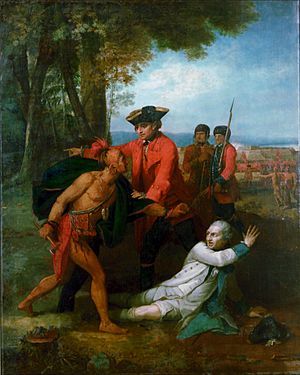
The battle ended the attack on Crown Point. Johnson built Fort William Henry at Lake George to make British defenses stronger. In December, Johnson resigned as a major general.
Even though the Battle of Lake George was not a huge victory, the British needed a hero. Johnson became that hero. He was given £5,000 by Parliament, and King George made him a baronet.
In January 1756, the British government made Johnson the only Superintendent of Indian Affairs for the northern colonies. This gave him great power. He reported directly to London and was not controlled by local governments. Johnson knew the Iroquois Six Nations, especially the Mohawk, best. He made the Iroquois the main focus of British diplomacy.
Capture of Fort Niagara
Johnson was no longer a general, but he still led Iroquois and frontier soldiers. In August 1757, after the French started to attack Fort William Henry, Johnson arrived at Fort Edward with 180 Indians and 1,500 militia. The British general, Daniel Webb, thought the French army was much larger than it was. He decided not to send help to Fort William Henry. The British had to surrender Fort William Henry, and many were killed in a terrible event afterwards.
The war was going badly for the British. Johnson found it hard to get the Six Nations to join, as they didn't want to join a losing side. In July 1758, he managed to gather 450 warriors for a large expedition led by General James Abercrombie. This campaign ended badly when Abercrombie failed to take Fort Carillon from the French.

In 1758, the war began to turn in favor of the British. Johnson was able to recruit more Iroquois warriors. In the summer of 1759, he led almost 1,000 Iroquois warriors as part of General John Prideaux's mission to capture Fort Niagara. When Prideaux was killed, Johnson took command.
He captured the fort after ambushing and defeating a French relief force at the Battle of La Belle-Famille. Johnson is usually given credit for leading this ambush. The capture of Niagara pushed the French back from the Great Lakes. Johnson was again celebrated as a hero. He commanded the "largest Native American force ever assembled under the British flag."
Johnson joined General Jeffery Amherst in the final campaign of the Seven Years' War in North America, the capture of Montreal in 1760. After New France fell to the British, Johnson spent a lot of time talking with the Native American allies of the French. In 1761, Johnson traveled 1,000 miles to Detroit for a meeting with American Indians. He tried to stop anti-British rumors and prevent resistance to the British military.
After the War
After the French and Indian War, Johnson wanted to expand his land. In 1760, the Mohawk of Canajoharie gave Johnson about 80,000 acres north of the Mohawk River. This land grant was controversial because other land buyers already had permission to buy lands the Mohawk were selling. But Johnson eventually got royal approval for the grant in 1769.
This was one of several large areas of land Johnson got from the Mohawk and Iroquois. He used his position as a royal Indian agent to do this. By the time he died, Johnson owned about 170,000 acres. He was one of the biggest landowners in British America.

In 1762, Johnson founded the city of Johnstown on his land, about 25 miles west of Schenectady. He named it after his son, John. There, he started a free school for both white and Mohawk children.
Outside of town, in 1763, he built Johnson Hall, where he lived until his death. He brought many Irish immigrant farmers to work on his lands. He also bought enslaved Africans to work as laborers, especially in his lumber business. Johnson had about 60 enslaved people, making him the largest slaveholder in the area.
Johnson supported the Anglican Church. To counter French Catholic missionaries, he paid for an Anglican church for the Mohawk in 1769. This building, known as Indian Castle Church, still stands today. In 1771, Johnson built St. John's Episcopal Church in Johnstown.
Pontiac's War and Final Years

In 1763, Pontiac's War began. Native Americans were unhappy with British policies after the French and Indian War. For years, Johnson had told General Jeffery Amherst to follow Iroquois customs, like giving gifts to Native leaders. Amherst ignored this advice and was replaced by General Thomas Gage. This made Johnson's position stronger. Johnson negotiated a treaty with Pontiac in 1766, which finally ended the war.
From July to August 1764, Johnson negotiated a treaty at Fort Niagara with about 2,000 American Indians, mostly Iroquois. Johnson convinced the Iroquois to send a war party against the Seneca who had joined the uprising.
Johnson supported the Royal Proclamation of 1763. This proclamation limited colonial expansion westward. Johnson negotiated the details of the boundary in the Fort Stanwix Treaty of 1768. He pushed the boundary 400 miles to the west, allowing him and other land buyers to get much more land than the British government had planned. He was criticized for this, but the expanded boundary was allowed to stand.
Native American unhappiness continued in the west in the 1770s. Johnson spent his last years trying to prevent another uprising like Pontiac's War. He worked to stop different Native American tribes from forming alliances. His last success was isolating the Shawnee before Dunmore's War in 1774.
Family Life
Johnson had a family with Catherine Weisenberg and Molly Brant, a German woman and a Mohawk woman. He also had other children.
Death and Legacy
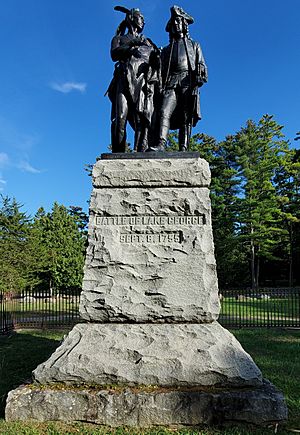
Johnson died from a stroke at Johnson Hall on July 11, 1774, during an Indian conference. His funeral in Johnstown was attended by over 2,000 people. He was buried under the altar in St. John's Episcopal church, which he founded. The next day, chiefs of the Six Nations recognized his nephew, Guy Johnson, as his successor.
During the American Revolution, the New York government took all of Johnson's land and property because his heirs supported the British. In 1960, Johnson Hall was named a National Historic Landmark. It is now a State Historic Site and is open to the public.
Johnson's most important legacy is the peaceful relationship between Anglo-Americans and Indians during his time as Indian Agent. As an adopted Mohawk chief and husband of Molly Brant, he was a trusted advisor and member of the Mohawk nation. This allowed him to lead Iroquois into battle with the English and negotiate two treaties of Fort Stanwix. While these treaties took land from some Indians, they gave good terms to the Iroquois. This led to decades of peace between Native American residents and new settlers.
Johnson also helped protect British control and Anglo-American settlement against French influence in northern New York and the Great Lakes region. He was key in keeping the British-Iroquois alliance strong through the Covenant Chain. This alliance helped both Iroquois and British land and trade interests against the French before 1763. After Britain took control of former French lands, Johnson won a political argument about Indian policy with Lord Jeffery Amherst. It was to Johnson that Pontiac finally surrendered after Pontiac's War ended.
Old Fort Johnson, his first home built in 1749, is now used by the Montgomery County Historical Society as a museum. Guy Park Manor, built in 1773 for Johnson's daughter Mary and her husband Guy Johnson, is also open to the public.
In Popular Culture
The Johnstown High School mascot is "Sir Bill" in Johnson's honor. The teams' sportswear often shows Johnson's silhouette wearing a tricorne hat.
He is a character in the book Manituana by Wu Ming and in Robert Louis Stevenson's novel, The Master of Ballantrae (1889).
Johnson was played by Pierce Brosnan in the television movie The Broken Chain (1993).
Actor Jeff Monahan played Johnson in the PBS docudrama The War that Made America (2006).
Wilderness Empire (1968), by Allan W Eckert, tells Johnson's story as historical fiction.
Images for kids
See also
 In Spanish: William Johnson para niños
In Spanish: William Johnson para niños


